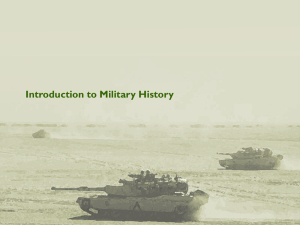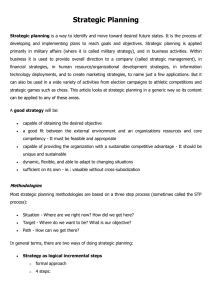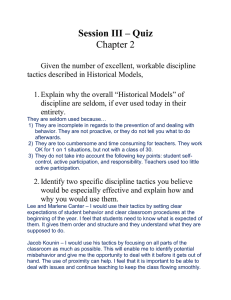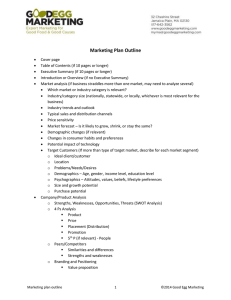Document 15075435
advertisement
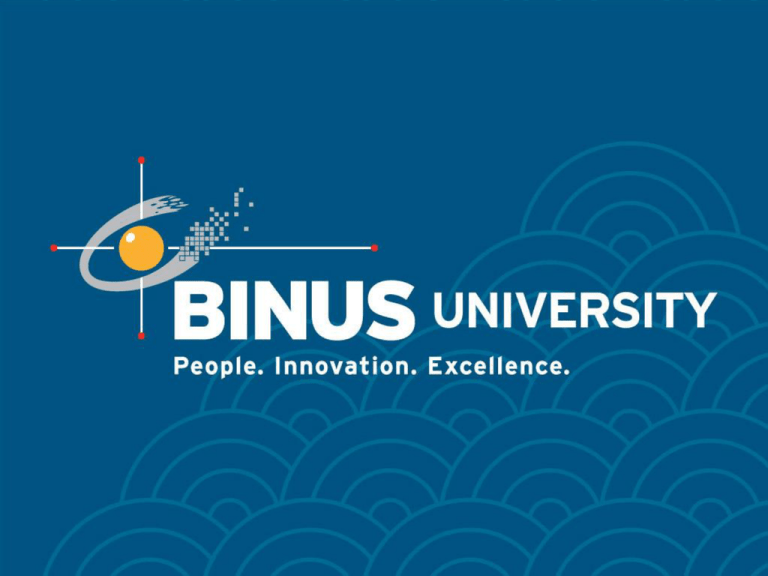
Mata kuliah : J0782 - Kepemimpinan Entrepreneurial Global Tahun : 2010 Kekuasaan dan Pengaruh Chapter 6 Learning Objectives • Understand how position and personal attributes can be a source of power for leaders • Understand the process by which power is acquired or lost in organizations • Understand the consequences of power for leadership effectiveness Learning Objectives (Cont.) • Understand some of the psychological processes that explain how leaders influence people • Understand the different types of influence tactics used in organizations • Understand how proactive tactics are typically used in influence attempts with subordinates, peers, or superiors • Understand the relative effectiveness of different proactive tactics Conceptions of Power and Influence • Power – Capacity of one party to influence another party • Authority – The rights, prerogatives, obligations, and duties associated with particular positions in an organization or social system Outcomes of Influence Attempts • Commitment – The target person internally agrees with a decision or request and makes a great effort to carry out the request • Compliance – The target person is willing to do what the agent asks but is apathetic rather than enthusiastic about it and will make only a minimal effort • Resistance – The target person is opposed to the proposal or request and actively tries to avoid carrying it out Types of Resistance • Refuse to carry out the request • Make excuses about why the request cannot be carried out • Try to persuade the agent to withdraw or change the request • Ask higher authorities to overrule the agent’s request • Delay acting in the hope that the agent will forget about the request • Make a pretense of complying but try to sabotage the task. Influence Processes • Instrumental Compliance – The target person carries out a requested action for the purpose of obtaining a reward or avoiding punishment • Internalization – The target person becomes committed to supporting and implementing the agent’s proposals because they appear to be intrinsically desirable and correct • Personal Identification – The target person imitates the agent’s behavior or adopts the same attitudes to please the agent and to be like the agent Power Types and Sources Different Types of Power Guidelines for Using Legitimate Authority • • • • • • • Make polite, clear requests Explain the reasons for a request Do not exceed your scope of authority Verify authority if necessary Follow proper channels Follow up to verify compliance Insist on compliance if appropriate Guidelines for Using Reward Power • • • • Offer the type of rewards that people desire Offer rewards that are fair and ethical Do not promise more than you can deliver Explain the criteria for giving rewards and keep it simple • Provide rewards as promised if requirements are met • Use rewards symbolically (not in a manipulative way) Guidelines for Using Coercive Power • Explain rules and requirements, and ensure that people understand the serious consequences of violations • Respond to infractions promptly and consistently without showing favoritism to particular individuals • Investigate to get the facts before using reprimands or punishment, and avoid jumping to conclusions or making hasty accusations • Except for the most serious infractions, provide sufficient oral and written warnings before resorting to punishment • Administer warnings and reprimands in private, and avoid making rash threats Guidelines for Using Coercive Power (Cont.) • Stay calm and avoid the appearance of hostility or personal rejection • Express a sincere desire to help the person comply with role expectations and thereby avoid punishment • Invite the person to suggest ways to correct the problem, and seek agreement on a concrete plan • Maintain credibility by administering punishment if noncompliance continues after threats and warnings have been made • Use punishments that are legitimate, fair, and commensurate with the seriousness of the infraction Ways to Acquire and Maintain Referent Power • • • • • • • Show acceptance and positive regard Act supportive and helpful Use sincere forms of ingratiation Defend and back up people when appropriate Do unsolicited favors Make self-sacrifices to show concern Keep promises Ways to Use and Maintain Expert Power • Explain the reasons for a request or proposal and why it is important • Provide evidence that a proposal will be successful • Do not make rash, careless, or inconsistent statements • Do not lie, exaggerate, or misrepresent the facts • Listen seriously to the person’s concerns and suggestions • Act confident and decisive in a crisis How Power is Acquired or Lost • Social Exchange Theory – Power based on exchange of benefits or favors – Acquired • • • • • Control over scarce resources Access to vital information Skill in dealing with critical problems Accumulated idiosyncratic credits Innovative proposals – Lost • • • • Pursuing selfish motives Innovation (if leads to failure) How serious the failure is Amount of status How Power is Gained or Lost • Strategic Contingencies Theory – Expertise in coping with important problems – Centrality of the subunit within the workforce – Extent to which the subunit’s expertise is unique rather than substitutable Power • Consequences of Position and Personal Power – Personal power positively correlated to satisfaction and performance – Position power non-significant or negative relationship with satisfaction and performance – All types of power can be effective in gaining limitations of power studies Power (Cont.) • How Much Power Should Leaders Have? – Depends on the what needs to be accomplished and the leader’s skill in using the power – Depends on the situation – Too much power may be as dangerous as not enough power Influence Tactics • General Types of Influence Tactics – Impression Management Tactics: Intended to influence people to like the agent or to have a favorable evaluation of the agent – Political Tactics: Used to influence organizational decisions or otherwise gain benefits for an individual or group – Proactive Influence Tactics: Have an immediate task objective – Reactive Influence Tactics: Used to resist an unwanted influence attempt or to modify the agent’s request to be more acceptable Research to Identify Proactive Tactics • Kipnis, Schmidt, and Wilkinson: Preliminary taxonomy • Schriesheim & Hinkin: Profiles of Organizational Influence Strategies (POIS) • Yukl & Colleagues: Influence Behavior Questionnaire Comparison Between POIS & IBQ Influence Tactics (Cont.) Power and Influence Behavior Use and Effectiveness of Influence Tactics Guidelines for Using Core Tactics Guidelines for Using Supplementary Tactics Guidelines for Using Supplementary Tactics (Cont.) Proactive Influence Tactics • • • • Effectiveness of Tactic Combinations Reactive Combinations Ethical Use of Influence Tactics Limitations of Research on Proactive Influence Tactics
